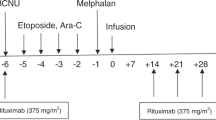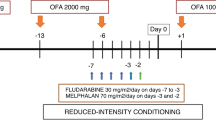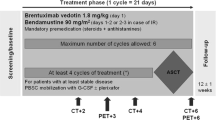Summary:
High-dose chemotherapy using melphalan (HDMEL) is an important component of many conditioning regimens that are given before autologous hematopoietic stem cell transplantation (AHSCT). In contrast to the situation in myeloma, and to a lesser degree acute leukemia, only a very limited published experience exists with the use of HDMEL conditioning as a single agent in doses requiring AHSCT for lymphoma, both Hodgkin lymphoma (HL) and especially non-Hodgkin lymphoma (NHL). Thus, we report results of treating 26 lymphoma patients (22 with NHL and four with HL) with HDMEL 220–300 mg/m2 plus amifostine (AF) cytoprotection and AHSCT as part of a phase I–II trial. Median age was 51 years (range 24–62 years); NHL histology was varied, but was aggressive (including transformed from indolent) in 19 patients, indolent in two patients and mantle cell in one. All 26 patients had been extensively treated; 11 were refractory to the immediate prior therapy on protocol entry and two had undergone prior AHSCT. All were deemed ineligible for other, ‘first-line’ AHSCT regimens. Of these 26 patients, 22 survived to initial tumor evaluation on D +100. At this time, 13 were in complete remission, including four patients who were in second CR before HDMEL+AF+AHSCT. Responses occurred at all HDMEL doses. Currently, seven patients are alive, including five without progression, with a median follow-up in these latter patients of D +1163 (range D +824 to D +1630); one of these patients had a nonmyeloablative allograft as consolidation on D +106. Conversely, 14 patients relapsed or progressed, including five who had previously achieved CR with the AHSCT procedure. Two patients, both with HL, remain alive after progression; one is in CR following salvage radiotherapy. Six patients died due to nonrelapse causes, including two NHL patients who died while in CR. We conclude that HDMEL+AF+AHSCT has significant single-agent activity in relapsed or refractory NHL and HL. This experience may be used as a starting point for subsequent dose escalation of HDMEL (probably with AF) in established combination regimens.
This is a preview of subscription content, access via your institution
Access options
Subscribe to this journal
Receive 12 print issues and online access
$259.00 per year
only $21.58 per issue
Buy this article
- Purchase on Springer Link
- Instant access to full article PDF
Prices may be subject to local taxes which are calculated during checkout


Similar content being viewed by others
References
Mink SA, Armitage JO . High-dose therapy in lymphomas: a review of the current status of allogeneic and autologous stem cell transplantation in Hodgkin's disease and non-Hodgkin's lymphoma. Oncologist 2001; 6: 247–256.
Shipp MA, Abeloff MD, Antman KH et al. International consensus conference on high-dose therapy with hematopoietic stem cell transplantation in aggressive non-Hodgkin's lymphomas: report of the jury. J Clin Oncol 1999; 17: 423–429.
Hahn T, Wolff SN, Czuczman M et al. ASBMT Expert Panel. The role of cytotoxic therapy with hematopoietic stem cell transplantation in the therapy of diffuse large cell B-cell non-Hodgkin's lymphoma: an evidence based review. Biol Blood Marrow Transplant 2001; 7: 308–331.
Hunault-Berger M, Ifrah N, Solal-Celigny P, Groupe Ouest-Est des Leucemies Aiguee et des Maladies du Sang. Intensive therapies in follicular non-Hodgkin lymphomas. Blood 2002; 100: 1141–1152.
Reece DE . Hematopoietic stem cell transplantation in Hodgkin's disease. Curr Opin Oncol 2002; 14: 165–170.
Mounier N, Gisselbrecht C . Conditioning regimens before transplantation in patients with aggressive non-Hodgkin's lymphoma. Ann Oncol 1998; 9 (Suppl. 1): S15–S21.
Salar A, Sierra J, Gandarillas M et al., for the GEL/TAMO Spanish Cooperative Group. Autologous stem cell transplantation for clinically aggressive non-Hodgkin's lymphoma: the role of preparative regimens. Bone Marrow Transplant 2001; 27: 405–412.
Sureda A, Arranz R, Iriondo A et al., Grupo Espanol de Linfomas/Transplante Autologo de Medula Osea Spanish Cooperative Group. Autologous stem-cell transplantation for Hodgkin's disease: results and prognostic factors in 494 patients from the Grupo Espanol de Linfomas/Transplante Autologo de Medula Osea Spanish Cooperative Group. J Clin Oncol 2001; 19: 1395–1404.
Mills W, Chopra R, McMillan A et al. BEAM chemotherapy and autologous bone marrow transplantation for patients with relapsed or refractory non-Hodgkin's lymphoma. J Clin Oncol 1995; 13: 588–595.
Williams CD, Goldstone AH, Pearce RM et al. Purging of bone marrow in autologous bone marrow transplantation for non-Hodgkin's lymphoma: a case-matched comparison with unpurged cases by the European Blood and Marrow Transplant Lymphoma Registry. J Clin Oncol 1996; 14: 2454–2464.
Demirkazik A, Kessinger A, Armitage JO et al. Progenitor and lymphoma cells in blood stem cell harvests: impact on survival following transplantation. Bone Marrow Transplant 2001; 28: 207–212.
Samuels BL, Bitran JD . High-dose intravenous melphalan: a review. J Clin Oncol 1995; 13: 1786–1799.
Lazarus HM, Herzig RH, Graham-Pole J et al. Intensive melphalan chemotherapy and cryopreserved autologous bone marrow transplantation for the treatment of refractory cancer. J Clin Oncol 1983; 1: 359–367.
Moreau P, Milpied N, Mahe B et al. Melphalan 220 mg/m2 followed by peripheral blood stem cell transplantation in 27 patients with advanced multiple myeloma. Bone Marrow Transplant 1999; 23: 1003–1006.
Singhal S, Powles R, Treleaven J et al. Melphalan alone prior to allogeneic bone marrow transplantation from HLA-identical sibling donors for hematologic malignancies: alloengraftment with potential preservation of fertility in women. Bone Marrow Transplant 1996; 18: 1049–1055.
Millar JL, McElwain TJ, Clutterbuck RD, Wist EA . The modification of melphalan toxicity in tumor bearing mice by s-2-(3-aminoprophylamino)-ethylphosphorothioic acid (WR2721). Am J Clin Oncol 1982; 5: 321–328.
Capelli D, Santini G, De Souza C et al. Amifostine can reduce mucosal damage after high-dose melphalan conditioning for peripheral blood progenitor cell autotransplant: a retrospective study. Br J Haematol 2000; 110: 300–307.
Capizzi RL . The preclinical basis for broad-spectrum selective cytoprotection of normal tissues from cytotoxic therapies by amifostine. Semin Oncol 1999; 26 (Suppl. 7): 3–21.
Shaw LM, Bonner H, Lieberman R . Pharmacokinetic profile of amifostine. Semin Oncol 1996; 23 (Suppl. 8): 18–22.
Kuittinen O, Ruokolainen H, Turpeenniemi-Hujanen T . Amifostine does not protect malignant lymphoma cell lines from the cytotoxic effects of various chemotherapeutics in vitro. Leukemia Lymphoma 2001; 42: 507–510.
Phillips GL, Adams VR, Badros A et al. Amifostine and autologous hematopoietic stem cell support of escalating-dose melphalan: a phase I study. (submitted for publication) 2003.
Reece DE, Vesole D, Flomenberg N et al. Intensive therapy with high-dose melphalan (MEL) 280 mg/m2 plus amifostine cytoprotection and ASCT as part of initial therapy in patients with multiple myeloma [abstract]. Proc Am Soc Hematol 2002; 100: 432a.
Harris HL, Jaffe ES, Diebold J et al. The World Health Organization classification of neoplasms of the hematologic and lymphoid tissues: report of the Clinical Advisory Committee meeting – Airlie House, Virginia, November, 1997. Hematol J 2000; 1: 53–66.
Philip T, Armitage JO, Spitzer G et al. High-dose therapy and autologous bone marrow transplantation after failure of conventional chemotherapy in adults with intermediate-grade or high-grade non-Hodgkin's lymphoma. N Engl J Med 1987; 316: 1493–1498.
Cheson BD, Horning SJ, Coiffier B et al. Report of an international workshop to standardize response criteria for non-Hodgkin's lymphomas. NCI Sponsored International Working Group. J Clin Oncol 2000; 18: 2351.
Bearman SI, Appelbaum FR, Back A et al. Regimen-related toxicity and early posttransplant survival in patients undergoing marrow transplantation for lymphoma. J Clin Oncol 1989; 7: 1288–1294.
Stockerl-Goldstein KE, Reddy SA, Horning SF et al. Favorable treatment outcome in non-Hodgkin's lymphoma patients with ‘poor’ mobilization of peripheral blood progenitor cells. Biol Blood Marrow Transplant 2000; 6: 506–512.
Kaplan EL, Meier P . Nonparametric estimation from incomplete observations. J Am Stat Assoc 1958; 53: 457–481.
Fisher RI . Overview of non-Hodgkin's lymphoma: biology, staging, and treatment. Semin Oncol 2003; 30 (Suppl. 4): 3–9.
Moreau P, Facon T, Attal M et al. for the Intergroupe Francophone du Muelome. Comparison of 200 mg/m2 melphalan and 8 Gy total body irradiation plus 140 mg/m2 melphalan as conditioning regimens for peripheral blood stem cell transplantation in patients with newly diagnosed multiple myeloma: final analysis of the Intergroupe Francophone du Myelome 9502 randomized trial. Blood 2002; 3: 731–735.
Stewart DA, Guo D, Sutherland JA et al. Single-agent high-dose melphalan salvage therapy for Hodgkin's disease: cost, safety, and long-term efficacy. Ann Oncol 1997; 8: 1277–1279.
Bergsagel PL . Chemotherapy of multiple myeloma: melphalan – 40 years old and still going strong. Biol Blood Marrow Transplant 2003; 9: 2–3.
Cesaro S, Meloni G, Messina C et al. Italian Pediatric Group for Bone Marrow Transplantation. High-dose melphalan with autologous hematopoietic stem cell transplantation for acute myeloid leukemia: results of a retrospective analysis of the Italian Pediatric Group for Bone Marrow Transplantation. Bone Marrow Transplant 2001; 28: 131–136.
Chopra R, Linch DC, McMillan AK et al. Mini-BEAM followed by BEAM and ABMT for very poor risk Hodgkin's disease. Br J Haematol 1992; 81: 197–202.
Russell JA, Selby PJ, Ruether BA et al. Treatment of advanced Hodgkin's disease with high dose melphalan and autologous bone marrow transplantation. Bone Marrow Transplant 1989; 4: 425–429.
Adams V, Phillips GL, Hale G et al. Pharmacokinetics and toxicity of escalating doses of melphalan (MEL) given with amifositine (AMI) cytoprotection (CP) in autologous hematopoietic stem cell transplantation (AHSCT): a Phase I-II study [abstract]. Proc Am Soc Clin Oncol 2000; 920a.
Buschini A, Anceschi E, Carlo-Stella C et al. Amifostine (WR-2721) selective protection against melphalan genotoxicity. Leukemia 2000; 14: 1642–1651.
Douay L, Hu C, Giaratana MC et al. Amifostine improves the antileukemic therapeutic index of mafosfamide: implications for bone marrow purging. Blood 1995; 86: 2849–2855.
List AF, Gerner EW . Amifostine: a tonic of toxin to myeloid progenitors. Leukemia Res 2001; 24: 1009–1011.
Capelli D, Santini G, De Souza C et al. Amifostine can reduce mucosal damage after high-dose melphalan conditioning for peripheral blood progenitor cell autotransplant: a retrospective study. Br J Haematol 2000; 110: 300–307.
Chauncey TR, Gooley TA, Lloid ME et al. Pilot trial of cytoprotection with amifostine given with high-dose chemotherapy and autologous peripheral blood stem cell transplantation. Am J Clin Oncol 2000; 23: 406–411.
Cronin S, Uberti JP, Ayash LJ et al. Use of amifostine as a chemoprotectant during high-dose chemotherapy in autologous peripheral blood stem cell transplantation. Bone Marrow Transplant 2000; 26: 1247–1249.
Renner S, Krumpelmann S, Bruchelt G et al. Effect of amifostine on neuroblastoma during high dose chemotherapy: in vivo and in vitro investigations. Anticancer Res 2000; 20: 4531–4538.
Hartmann JT, von Vangerow A, Fels LM et al. A randomized trial of amifostine in patients with high-dose VIC chemotherapy plus autologous blood stem cell transplantation. Br J Cancer 2001; 84: 313–320.
Thieblemont C, Dumontet C, Saad H et al. Amifostine reduces mucosal damage after high-dose melphalan conditioning and autologous peripheral blood progenitor cell transplantation for patients with multiple myeloma. Bone Marrow Transplant 2002; 30: 769–775.
Jantunen E, Kuittien T, Nousiaien T . A pilot study on feasibility and efficacy of amifostine preceding high-dose melphalan with autologous stem cell support in myeloma patients. Leukemia Lymphoma 2002; 43: 1961–1965.
Wun T, Kwon DS, Tuscano JM . Radioimmunotherapy: potential as a therapeutic strategy in non-Hodgkin's lymphoma. BioDrugs 2001; 15: 151–162.
Press OW, Eary JF, Gooley T et al. A phase I/II trial of iodine-131-tositumomab (anti-CD20), etoposide, cyclophosphamide, and autologous stem cell transplantation for relapsed B-cell lymphoma. Blood 2000; 96: 2934–2942.
Acknowledgements
We thank our patients for their willingness to undergo clinical research studies; our nursing colleagues for their excellent patient care; our medical consultants for their valuable assistance; our data coordinators, and Ms M Coddington, Ms Lynn Stull and Ms Linda Wilkinson for their expert help with manuscript preparation. Finally, we thank Dr J Friedberg for his helpful suggestions with the manuscript. Grant support for this study was provided by the NIH, RO3CA80666 and ALZA.
Author information
Authors and Affiliations
Corresponding author
Rights and permissions
About this article
Cite this article
Phillips, G., Meisenberg, B., Reece, D. et al. Activity of single-agent melphalan 220–300 mg/m2 with amifostine cytoprotection and autologous hematopoietic stem cell support in non-Hodgkin and Hodgkin lymphoma. Bone Marrow Transplant 33, 781–787 (2004). https://doi.org/10.1038/sj.bmt.1704424
Received:
Accepted:
Published:
Issue Date:
DOI: https://doi.org/10.1038/sj.bmt.1704424
Keywords
This article is cited by
-
BU and CY as conditioning regimen for autologous transplant in patients with multiple myeloma
Bone Marrow Transplantation (2009)
-
Oral mucositis in myeloma patients undergoing melphalan-based autologous stem cell transplantation: incidence, risk factors and a severity predictive model
Bone Marrow Transplantation (2006)



